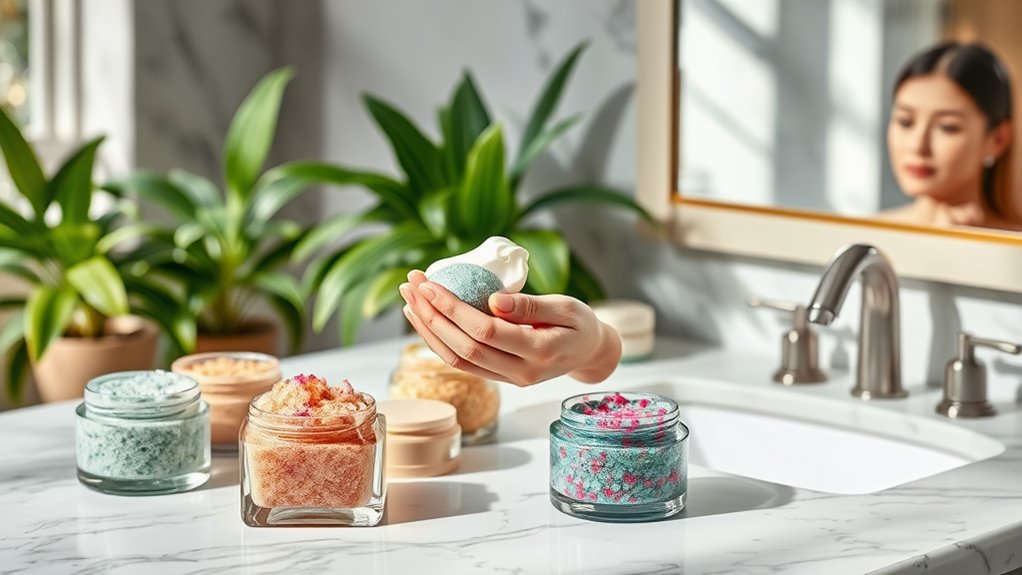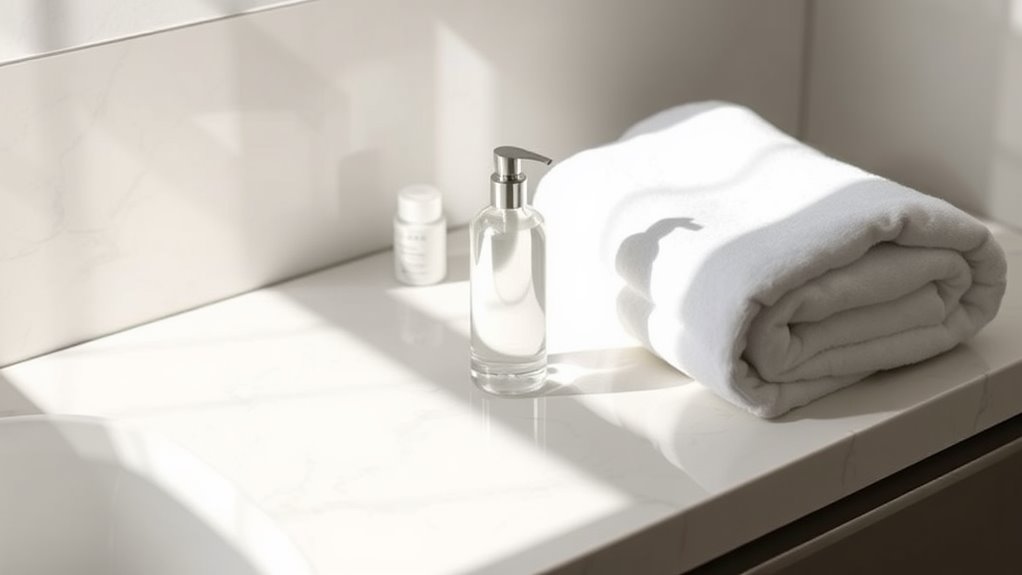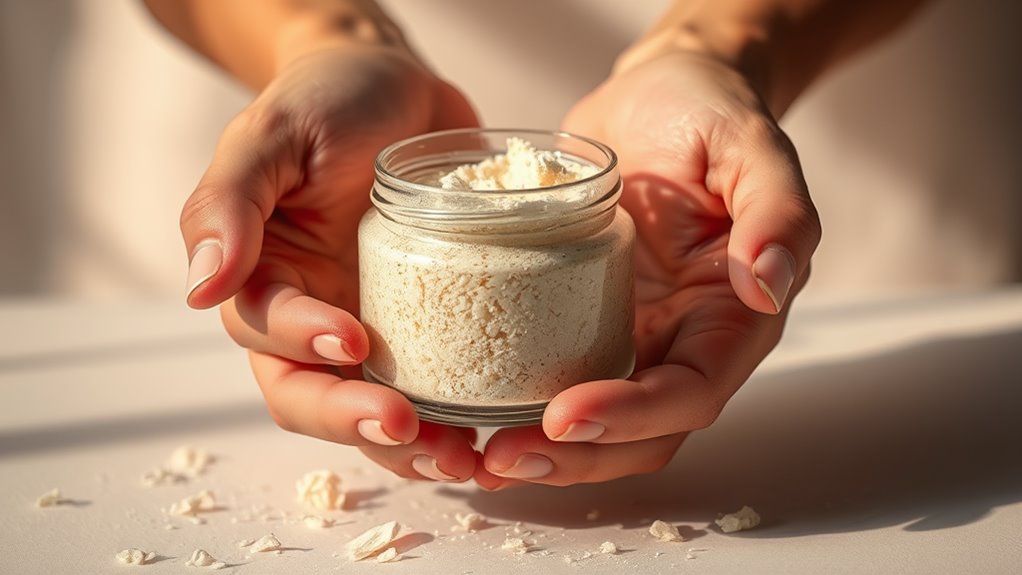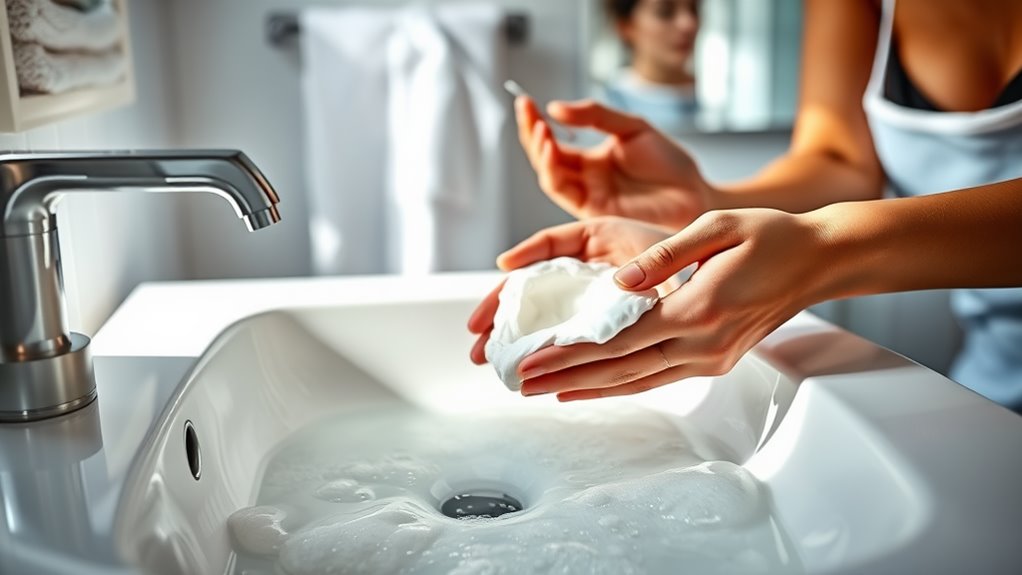What Dermatologists Say About Daily Exfoliating – You Might Be Doing It Wrong
Dermatologists warn that daily exfoliating can harm your skin if you don’t follow proper guidelines. Over-exfoliation can lead to irritation, dryness, and compromised skin barriers. It’s vital to choose the right type of exfoliant—physical or chemical—and limit exfoliation based on your skin type. While oily skin may tolerate more frequent exfoliation, others should be cautious. To maintain healthy skin, it’s essential to recognize the signs of over-exfoliation and establish a safe routine. Discover more essential tips to keep your skin glowing.
Key Takeaways
- Daily exfoliation can strip essential oils, leading to dryness and irritation, especially for sensitive skin types.
- Over-exfoliating disrupts the skin barrier, increasing the risk of breakouts and long-term damage.
- Dermatologists recommend exfoliating 2-3 times a week, tailored to individual skin types and sensitivities.
- Choosing the right exfoliant—physical or chemical—is crucial for effective and safe exfoliation.
- Always follow exfoliation with a hydrating moisturizer and sunscreen to protect and restore skin health.
Understanding Exfoliation: What It Is and Why It Matters
Exfoliation is the process of removing dead skin cells from the surface of your skin, and it’s crucial for maintaining a healthy complexion.
To master your exfoliating routine, you need to establish a consistent schedule that suits your skin type. Generally, exfoliating two to three times a week is ideal for most individuals, but this can vary depending on your skin’s sensitivity.
Always follow up with a moisturizer to replenish hydration after exfoliating. Pay attention to how your skin reacts; if irritation occurs, adjust the frequency or product. Over-exfoliating can lead to barrier damage, resulting in increased sensitivity and irritation.
Incorporating these practices into your skincare regimen not only enhances your skin’s texture but also promotes cell turnover, revealing a more radiant appearance.
Follow this exfoliating routine advice to achieve optimal results.
The Different Types of Exfoliants: Physical vs. Chemical
When it comes to exfoliation, you’ll encounter two main types: physical and chemical exfoliants. Physical exfoliants use manual scrubbing or abrasive particles to slough off dead skin, while chemical exfoliants employ acids or enzymes to dissolve the bonds between skin cells. Understanding these differences helps you choose the right method for your skin type and needs. Additionally, experts suggest that daily exfoliation can lead to irritation and compromised skin barriers if not done properly.
Physical Exfoliants Defined
Understanding physical exfoliants is essential for anyone looking to enhance their skincare routine. These products work by manually sloughing off dead skin cells using granular substances or tools.
Common types include scrubs containing sugar, salt, or ground nuts, as well as exfoliating brushes and sponges. When you apply a physical exfoliant, you create friction against your skin, which helps to reveal a smoother, more radiant complexion.
However, it’s vital to choose the right product for your skin type; for instance, sensitive skin may benefit from gentler options. Over-exfoliating can lead to irritation and damage, so limit your use to two to three times a week.
Mastering the application technique also ensures you achieve optimal results without compromising your skin’s health.
Chemical Exfoliants Explained
While physical exfoliants rely on manual techniques to remove dead skin, chemical exfoliants take a different approach by using active ingredients to dissolve the bonds between skin cells.
These exfoliants typically contain alpha hydroxy acids (AHAs) like glycolic acid and lactic acid, or beta hydroxy acids (BHAs) like salicylic acid.
AHAs work best for dry or sun-damaged skin, promoting moisture retention and enhancing cell turnover.
Conversely, BHAs penetrate deeper into pores, making them ideal for oily or acne-prone skin.
When incorporating chemical exfoliants into your routine, start slowly to gauge your skin’s tolerance, and always follow up with sunscreen.
Mastering these products can lead to a brighter, smoother complexion, but understanding their unique properties is key.
How Often Should You Exfoliate?
Understanding how often to exfoliate is crucial for maintaining healthy skin. Your skin type and the methods you choose play significant roles in determining the ideal frequency for exfoliation. Additionally, recognizing the signs of over-exfoliation will help you avoid damaging your skin. Over-exfoliating can lead to the effects of over-exfoliating, which may compromise your skin’s natural barrier and cause irritation.
Skin Type Considerations
Choosing the right exfoliation frequency hinges on your skin type. Understanding your unique needs helps you achieve optimal skin health. Here’s a breakdown to guide you:
-
Oily Skin: Exfoliate 2-3 times a week to manage excess oil and prevent breakouts.
-
Dry Skin: Limit exfoliation to once a week to avoid irritation and maintain moisture.
-
Sensitive Skin: Choose gentle exfoliation once every 1-2 weeks to prevent redness and discomfort.
-
Combination Skin: Exfoliate 1-2 times a week, focusing on oilier areas while being gentle on drier spots.
Tailoring your routine to your skin type maximizes benefits while minimizing adverse effects.
Mastering your exfoliation frequency is crucial for a radiant, healthy complexion.
Exfoliation Methods Explained
Knowing your skin type sets the stage for selecting the right exfoliation methods.
If you have oily or acne-prone skin, exfoliating two to three times a week is effective. For dry or sensitive skin, limit exfoliation to once a week to avoid irritation. Combination skin can benefit from a balanced approach, exfoliating once or twice weekly.
Chemical exfoliants, like AHAs and BHAs, offer deeper penetration and should be used according to your skin’s tolerance.
Physical exfoliants, featuring scrubs or brushes, provide immediate results but require caution to avoid overdoing it. Always follow up with a moisturizer to maintain hydration.
Pay attention to your skin’s reaction and adjust your routine as needed for optimal results.
Signs of Over-Exfoliation
How can you tell if you’re over-exfoliating your skin? Recognizing the signs is crucial for maintaining a healthy complexion. Here are four indicators that you might be going overboard:
-
Redness and irritation: Your skin may appear inflamed or sensitive.
-
Dry, flaky patches: Over-exfoliation can strip away essential oils, leading to dryness.
-
Increased breakouts: A disrupted skin barrier can trigger acne or other blemishes.
-
Tightness or discomfort: You might feel a persistent tightness, signaling that your skin’s natural moisture is compromised.
If you notice any of these symptoms, it’s time to reassess your exfoliation routine.
Aim for a balanced approach, typically exfoliating 1-3 times a week, depending on your skin type and product strength.
Common Mistakes to Avoid When Exfoliating
Exfoliating can be a game changer for your skincare routine, but many people make common mistakes that can lead to irritation or damage. Here are some pitfalls to avoid:
| Mistake | Consequence | Solution |
|---|---|---|
| Exfoliating too often | Skin irritation | Limit to 2-3 times a week |
| Using harsh scrubs | Micro-tears in skin | Opt for gentle exfoliators |
| Not moisturizing after | Increased dryness | Always follow with a moisturizer |
| Ignoring skin type | Ineffective results | Choose products suited for your skin type |
Exfoliation is crucial for maintaining rough and uneven skin texture and achieving a smooth complexion.
Signs You’re Over-Exfoliating Your Skin
Over-exfoliating your skin can lead to several telltale signs that indicate it’s time to reassess your routine.
If you notice any of the following symptoms, you might be overdoing it:
-
Redness and inflammation: Your skin appears irritated and sensitive, resembling a sunburn.
-
Flakiness and dryness: You experience excessive peeling or rough patches on your complexion.
-
Increased breakouts: Your skin may react by producing more acne or clogged pores.
-
Dullness: Instead of a radiant glow, your skin looks lackluster and lifeless.
Recognizing these signs is crucial for maintaining a balanced exfoliation routine. Over-exfoliating can lead to long-term damage that compromises your skin’s health and appearance.
If any of these symptoms appear, it’s a strong signal to dial back your exfoliating efforts and restore your skin’s health.
Expert Tips for a Safe and Effective Exfoliation Routine
To achieve a healthy glow without damaging your skin, it’s essential to adopt a safe and effective exfoliation routine.
Start by choosing the right type of exfoliant: physical for surface sloughing and chemical for deeper penetration. Limit your exfoliation to 1-3 times a week, depending on your skin type; sensitive skin benefits from less frequent exfoliation.
Always follow up with a hydrating moisturizer to restore balance. Pay attention to your skin’s response—if irritation occurs, reduce frequency or switch products.
Lastly, don’t forget sunscreen; exfoliation can make your skin more susceptible to UV damage.




